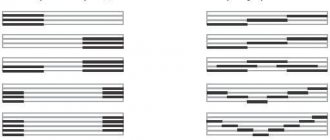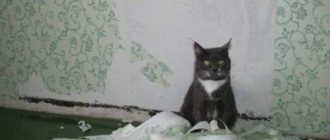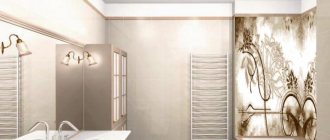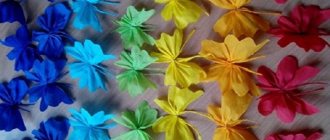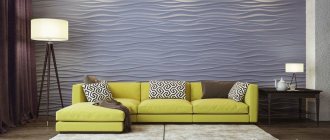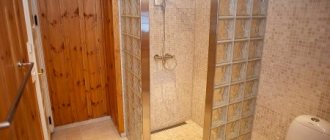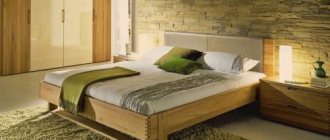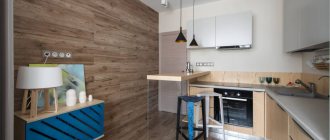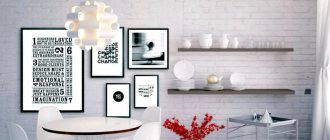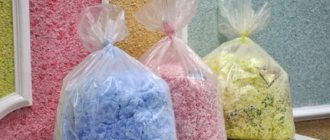Wall panels have taken their place in the building materials market relatively recently,
You can add originality to the room by decorating the walls with panels, but they have already managed to gain quite a good reputation. There is no need to fuss with such panels, like, for example, with wallpaper or paint; they ideally hide all the unevenness and other imperfections of the wall surfaces. As for the price, you can choose such material depending on the budget calculated for repairs, because the price for it is quite affordable for almost any person. You can order the simplest panels of one color, or you can buy panels in a designer design, which will cost more, of course.
Paint instead of wallpaper on the wall: types and advantages
Paint is one of the oldest materials that people used to decorate the walls of their homes. Decorative paint has a lot of undeniable advantages and is increasingly used for wall decoration instead of wallpaper. This is not such a cheap pleasure, because the paint itself costs a lot of money, and in order to apply it correctly and efficiently, you will need to make every effort. To decorate walls with paint, it is better to use the services of professionals, because an inexperienced beginner is unlikely to be able to cope with such a task on his own.
The walls can be painted in any color that will harmoniously fit into the interior
There are several types of wall paint. The most popular types:
- Structural;
- Decorative;
- Emulsion;
- Acrylic;
- Latex;
- Silicone;
- Polyvinyl acetate;
- Enamel;
- Oil, Silicate;
- Alkyd;
- Adhesive;
- Dextrinated;
- Casein.
Related article: Which heated floor heats better and consumes less resources
All these paints differ in their compositions and price categories, as well as application methods and service life. Detailed information can be seen on the containers with the material or you can check with the seller.
When choosing wall paint, be extremely careful, because one type will not suit all rooms in the apartment. One type is intended for the bathroom (moisture-resistant paint), and the second for the bedroom or nursery (environmentally friendly compositions).
As mentioned above, paint has a huge number of advantages. It is because of so many advantages that this material is so loved by people who make renovations in their premises.
Main advantages:
- Long service life of the material - about 10 years;
- The material does not fade when exposed to sunlight;
- The paint is not afraid of exposure to sharp objects;
- Easy to clean, unlike wallpaper;
- Huge selection of colors and shades;
- Water resistance and moisture resistance of some types;
- Versatility of the material;
- Antistatic coating of some types.
As you can see, this material really has a lot of good points, so it really is a good substitute for already established wallpaper. You can safely choose paint to decorate the walls in your home.
PVC panels: types and features
For more than 20 years, polyvinyl chloride has been used as a cladding material for external and internal walls in public, industrial and residential buildings. Thanks to their versatility, practicality and reasonable price, they quickly won over consumers.
| Differ by: | Advantages | Flaws | |||
| Views | Description | Coverage | Description | ||
| Lining | A set of slatted panels, length 3 m, width 10 cm. More popular is the “European” one with a wide lock. They can be attached to the sheathing or directly to the wall. Usually made in white. | Matte | Without applying any coating | They have the following qualities: moisture resistance, heat resistance, wear resistance, durability | Artificial origin of the material |
| Wide range of colors and designs | |||||
| Panels | The usual length is 25 cm. They differ from other types by an invisible seam after assembly. The surface is painted, varnish or thermal film is applied | Glossy | Covered with one or more layers of varnish for shine | Easy to care for | Prolonged heating releases toxic substances |
| Imitation of different textures | |||||
| Sheets | The width of the sheets is 80 cm - 2 m, length - 1.5 - 4 m. They are glued directly to the wall surface. Sheet panels are rarely used, since the surface preparation procedure is tedious | Drawings | Applied using thermal film | Ease of installation | Fading, turning yellow when exposed to direct sunlight |
| Images | Offset printing is used | ||||
| Tile | They are produced in the shape of a square, measuring 30 by 30 or 1 by 1 m. They are attached in the same way as lining. There are design options in the form of a mosaic or pattern | Colored | Painted during the production of the material itself by adding paint | Resistant to fungus and mold | Easily deformed by targeted impacts |
Modern room design with wall panel
Apartment interior with wall panel
Original room design using wall panels
See alsoAll the most interesting things about door decor
A worthy alternative to wallpaper for walls: decorative panels
Decorative wall panels really are a good alternative to outdated wallpaper. The type of panels can be as different as you can imagine, and accordingly the price will also be different. The advantages of the panels are that they are not very difficult to install, in a short period of time you can finish a fairly large area, all the imperfections of the walls will be hidden under the material, the room will immediately take on an expensive look.
Decorative panels may differ in texture, material and color
Wall panels are divided into:
- Tiled;
- Leafy;
- Rack and pinion.
All of these types are attached in the same way, so if you have already dealt with decorating walls with this material, you don’t have to worry about anything, because you already know what would be best to do when decorating the area to be treated.
Related article: How to disguise a gas boiler in the kitchen
The material from which the panels are made can be very diverse:
- Natural wood;
- Chipboard (chipboard);
- Fiberboard (wood fiber types);
- MDF panels;
- Durable glass;
- Gypsum vinyl;
- 3D panels;
- PVC;
- Plastic.
All these types of panels can have completely different characteristics, width, thickness and length, as well as a specific purpose. It is advisable to check all information from reliable sources or directly from the seller of these materials.
The use of decorative wall panels in the interior
When choosing a finishing material, you need to know where and how it can be used. Any factor affects the perception of the interior of the room, the atmosphere in the apartment, the mood, well-being and health of its inhabitants.
- Wood panels are installed in rooms with low humidity: living room, bedroom, children's room. With their help you can create an atmosphere of warmth and comfort.
- Fiberboard combines the warmth of nature and the evolution of modern technology. It is also recommended to mount in corridors, hallways, living rooms or bedrooms where there is no high humidity.
- Plasterboard panels are combined with mirror surfaces and create an inimitable look in the living room or bedroom. Thanks to plaster and gold moldings, you can create an elegant interior in a classic style.
- Soft finishing is appropriate in offices, bedrooms (creates an imitation of a palace), children's rooms - it serves as a safe covering.
- Decorating walls with bamboo can immerse you in a rustic country style and decorate the interior in ethnic and African style.
- Glass panels have proven themselves to be an ideal covering for kitchen splashbacks. A variety of drawings and “living” paintings creates a comfortable and pleasant environment.
See alsoDecor of corners with benefits and aesthetics
We are considering options: how to cover the walls in an apartment instead of wallpaper
Nowadays, there is simply an incredible amount of materials that can easily replace wall coverings such as wallpaper. There are options for absolutely every taste and in completely different price categories. There are simply a huge number of them, and it is simply impossible to list and describe everything.
Decorative panels with a wavy surface look good in an interior designed in modern or high-tech style
The most common alternative materials to wallpaper are:
- FLOCK;
- Decorative plaster;
- Dye;
- Decorative wall panels;
- Special fabric;
- Cork backing;
- Plastic;
- Drywall;
- Stone;
- Tile;
- Lining.
As you can see, you can decorate the walls of your home with a variety of materials. The choice of material should be guided, first of all, by the direction of the interior style. Everyone wants to have an even and smooth style, so that the picture is not spoiled by any one flaw.
To choose the ideal coating, it is better to consult with professional designers.
The easiest way would be to cover the walls of the building with plasterboard, plastic or decorative panels. Even a beginner can easily cope with this task, without much experience or training. Of course, it will be better if an experienced master handles this task, or at least just someone to help, since it will be much easier to complete this task together.
MDF panels
Finishing wall panels based on MDF are available in three forms: slatted, slab and sheet. Their surface can be finished with veneer or laminated (covered with film), or painted. The surface can be smooth or embossed, the color can be any, even floral. Most often, MDF panels imitate a wooden surface (can be the natural color of wood, lightened, tinted in different colors).
Traditional panels can be made from slab-type MDF wall panels
Also a good option
In classic interiors, MDF wall panels with imitation of valuable wood species are used: few people can distinguish veneered MDF from solid wood
Variations of colors - wood, smooth painted
Wild stone color options
Brick, stone, plant pattern... whatever you want
Veneer can be tinted in different shades
Another popular option is brickwork; stonework is a little less common. There are also plain-colored colors and, although they are presented in even cheaper materials such as fiberboard and chipboard, they are still bought. There are reasons for this:
- MDF is one of the safest materials. It is formed from wood waste ground into fibers and then pressed at high temperature. Under these conditions, a natural binder is released - lignin, which is contained in wood fibers. If there is not enough binder, add a binder previously isolated from other rocks. Therefore, MDF is considered a natural finishing material, it is approved for use in children's and medical institutions (the formaldehyde emission coefficient of this material is not higher than E1).
- MDF is not afraid of high humidity and reacts little to temperature changes. Therefore, MDF wall panels for interior decoration can be used in rooms with high humidity, but not where there is direct contact with water.
- You can create a relief of any complexity. Simpler designs are formed during pressing, while more voluminous and complex ones are formed using a milling cutter. This technology is used to make 3D MDF wall panels.
MDF wall panels with 3D effect - stylish
The design can be anything... floral, geometric, fantasy
The drawing could be like this
If you also add metallic paint...
Accent wall made of volumetric MDF panels for wall decoration
There are even carved
Several options with 3D MDF wall panels
This material still has a drawback: it costs a lot. The price depends on several factors:
- Densities.
- Material thickness.
- Difficulty in forming and painting.
The minimum price is from $30 per square meter, the maximum is up to several hundred dollars. But here you also need to understand that MDF wall panels have different purposes. Available for wall decoration. They have greater density and thickness (from 8 mm thick). Minimum price from $40. For finishing the ceiling. You can take thin ones (from 6 mm), since there is practically no mechanical load. But we must take into account the following fact: the thinner the MDF, the more often it is necessary to install hangers (fasteners). Otherwise, MDF panels may bend under their own weight. Fasteners cost money, so if you can save money, it will be insignificant. But you will spend more time on work.
Chipboard wall panels
Chipboard panels for wall decoration are made of sheet and slab types. The material is characterized by low resistance to humidity, so it is used exclusively in rooms with normal humidity. It also reacts poorly to cold, which is why it is not used on unheated loggias and balconies, bathhouses, and summer cottages.
Laminated or veneered wall panels for interior decoration made from chipboard look good in modern interiors
In the manufacture of chipboards, an artificial binder containing formaldehyde is used. In high concentrations, this substance is dangerous, because the production of the material is controlled by the sanitary and epidemiological station. Each batch of material is tested, and based on the results of laboratory tests, a hygienic certificate is issued with the emission class indicated in it. An excellent indicator is Super E and E1 (like natural wood), acceptable - E2. It is better not to use anything higher (more numbers) at home.
Chipboard wall panels for interior decoration are available laminated (coated with film) or veneered. Their range is not so wide - the material is weakly plastic, so the slabs are mostly smooth. Only some manufacturers have modern equipment that allows them to shape the relief. But, even with new equipment, the maximum that can be formed is imitation of brickwork, ceramic tiles, wood texture.
In this option, you can also use chipboard wall panels with veneer
Fastening can be secret - using clamps - or self-tapping screws. When fastening with self-tapping screws, holes of a smaller diameter are pre-drilled in the material. And we must remember that it will not be possible to reinstall the same fasteners. It is necessary to use a larger diameter, since the material crushes/crumbs and is not restored.
Gypsum panels for wall decoration
About 5 years ago, gypsum wall panels for interior decoration appeared on the market. This is an environmentally friendly finishing material, absolutely faithless and hypoallergenic. Another advantage is its absolute non-flammability. It is as flammable as stones. Overall a good choice.
This is how 3D gypsum wall panels for interior decoration are sold
Production technology makes it possible to create a relief of any complexity, so such slabs have a figured front surface. They are also called 3D wall slabs. The types of relief are very different. Geometric patterns of varying complexity, curved lines, circles, plant motifs and all this in combination. There are very, very many options and variations. Production technology has almost no limitations. And all this variety is available in two versions:
- Made from pure gypsum diluted with water. Can only be used in rooms with normal humidity, since gypsum is hygroscopic. When wet, it collapses. Area of application: corridors, living quarters.
- Moisture resistant with hydrophobic additives. Additives reduce absorbency so much that this type of finish can be used in rooms with high humidity. With some types of additives, they can be installed in places of direct contact with water - near bathtubs, washstands. They can be installed in bathrooms or as kitchen splashbacks.
In any case - moisture resistant or not - gypsum wall boards for interior decoration can be painted. This is perhaps the only option for painting. The paint can be anything. Its type is selected according to the task: if wet cleaning is expected, the paint must be wash-resistant; if plaster panels mounted on the walls of the pool are to be painted, paint with a water-resistant effect is needed (or coated with varnish).
3D plaster panels in the interior of the dining room, living room - just what the doctor ordered...
Longitudinal or horizontal arrangement - you choose, square slabs 50*50 cm, as you turn, so it will be
Painting and lighting are the secret to a bright interior
Gypsum wall panels are suitable for floor painting
One of the most perfect imitations of masonry is in gypsum panels
If you paint a geometric pattern with paint with a metallic effect and choose the right lighting, the interior will be unforgettable
Geometric abstraction is suitable for any room
Volumetric figures on 3D wall panels
You can find an unobtrusive pattern in the bedroom
Installation of gypsum boards for wall finishing - with glue. If the surface is flat, you can directly on the wall; if there are differences, you need to either level the wall or install a sheathing. Use universal glue, but make sure it is suitable for the materials used and can withstand sufficient load. One slab weighs about 2-4 kg. Not too much, but not a lot.
The seams between the plates can be left, or a seamless surface can be made. The choice depends on the type of terrain and type of room. There are slabs that are clearly “square”, so the seams look attractive. You just need to take into account that it is better not to do them in the bathroom or kitchen - it will cause unnecessary problems when cleaning. There are no such problems in living rooms - there is no severe pollution here.
Bamboo trim panels
A not very common, but interesting option is bamboo wall panels for interior decoration. They are made from bamboo cut into strips which are then woven into slabs of different sizes. After which the material is pressed, painted and varnished. Such bamboo panels are suitable for interiors in ethnic style, and more so in an oriental style. The resulting braid has different thicknesses - from 1 mm to 7 mm. Depending on the thickness, bamboo panels are glued to the ceiling (1-3 mm thick) or walls (4 mm and thicker).
Several types of wicker bamboo wall panels
Bamboo weaves go well with wood
Different texture and weave
The room may have an oriental style
Bamboo wall panels for interior decoration
Combined with bamboo wallpaper
Bamboo and cork also look organic side by side
There is another technology for producing bamboo wall panels. In this case, the stems are crushed to fibers and pressed at high temperatures. This is how 3D eco-friendly panels are made from bamboo. The same technology is used to produce similar material from cellulose and reed. The variety of patterns here is no less than in gypsum analogues, and the thermal conductivity is slightly less. The disadvantage is that they do not belong to the category of non-combustible materials. And one more thing: they are produced in China, Thailand, but there is no production in Russia yet.
Pictures may vary
Color matters too
The method of installing these volumetric finishing panels is with glue. The seams are puttied and leveled. The surface can be painted, but it must first be coated with a primer - to reduce and equalize the absorbency and so that the paint goes on more evenly. It is better to apply paint from a sprayer - it is difficult to paint the relief with a brush and completely impossible with a roller.
Metal panels for interior decoration
Wall panels for interior decoration are not used very often. We don’t associate metal, its shine with the comfort of home. Occasionally they can be seen in interiors in high-tech, loft, minimalism, art deco styles. As a rule, they are used to decorate an accent wall. In the most avant-garde interiors, metal wall panels can be seen on the ceiling.
High-tech uses polished or matte stainless steel, loft and art deco can use painted or artificially “rusted” black steel. Steel plates, but painted grey, black, red, can be minimalist.
Due to their resistance to water and moisture, stainless steel panels can be seen as a kitchen apron
For the daring ones - finishing the walls in the bedroom with steel wall panels
Aged copper is an excellent finishing material for Art Nouveau, loft style
Steel wall panels for interior decoration can also be different
Copper decorative panels for living room interiors
Most often, steel wall panels can be seen in the kitchen on the working wall
In combination with tiles
Another option for metal panels for kitchen splashbacks
Perforated plates made of painted galvanized steel are suitable for a study or office.
What kind of metal finishing panels can be used for premises?
For an apron. In general, this is a good option for finishing balconies and loggias. There are metal panels coated with a layer of colored polymer. They are used for exterior decoration of buildings, so they are not afraid of anything on unheated balconies. By the way, there are corrugated metal panels that are perfect for a suspended ceiling in wet rooms (bathroom, swimming pool) and will not interfere with ventilation.
Glass and mirror
Wall panels for interior decoration made of glass and mirrors appeared several years ago. As a rule, they are mounted on previously painted surfaces, protecting them from moisture. This technique works well in rooms with high humidity - bathrooms, kitchens. Tempered glass is used, consisting of several layers bonded together with a transparent polymer. Similar glasses are used as entrance doors. So they are safe as wall decoration.
If the painted walls in the bathroom are covered with glass panels, such finishing will not be demolished
With photo printing
Not many interiors use glass indoor wall panels
Mirrors are a great way to make your interior unusual
The reflection on the glass breaks up the space
Patterned glass on a plain painted wall gives an interesting result
There are also new trends - photo printing on glass. Using new technologies, any design or even a photograph can be applied to glass. Since such decorative panels still remain translucent, the wall must be painted. But the choice of color and tone depends on the desired effect.
Another non-standard type of wall panels is made from mirrors. They are also made from durable, film-glued sheets. Making a wall completely mirror is not always a good solution, but making stripes - vertical or horizontal - is an interesting idea. The interior immediately becomes fashionable and dynamic.
Choosing what to replace wallpaper on the walls with: the most affordable materials
If we talk about the most affordable materials for wall decoration, then it is worth considering the fact that you need to understand what kind of room we are talking about and directly what room the renovation is planned for. If the whole house and all its rooms are planned to be done in the same style direction, then this problem disappears.
Related article: Photo of bathroom and toilet renovation: before and after
An excellent solution is to decorate the walls with decorative stone
From the most accessible materials you can use:
- GLV;
- chipboard;
- Fiberboard.
Despite the affordable price, these materials have several significant advantages. Despite the fact that the affordable price itself is already an important advantage, these materials have a couple more advantages. The fact is that one sheet, be it GLV, fiberboard or chipboard, covers a large area of the surface being processed, so you don’t have to purchase a lot of materials, and you can do the finishing yourself.
It is best to decorate the corridor with clapboard or stone (despite the fact that these materials are not the most affordable) since this part of the room is the most accessible room.
